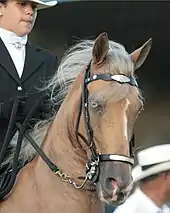Tiger eye
Tiger eye or goat eye is a gene causing diluted eye color in horses. There are two variants, Tiger-eye 1 (TE1) and Tiger-eye 2 (TE2), which are both recessive.[1] Horses displaying tiger eye typically have a yellow, orange, or amber iris. Tiger eye has only been found in Puerto Rican Paso Fino horses. Horses of related breeds were tested (90 Colombian Pasos, 20 Mangalargas, 44 Lusitanos, and 42 Andalusian horses), and none were found to have either tiger eye allele. No obvious link between eye shade and coat color was seen, making this the first studied gene in horses to affect eye color but not coat color. Tiger eye does not appear to affect vision, and there were no signs of reduced pigment on the retina or retinal pigment epithelium.[2]

Genotypes
Molecular genetics
The gene involved codes for SLC24A5, a solute carrier known to be involved in pigmentation in other species. SLC24A5 is found on equine chromosome 1 base pairs 141,657,837–141,678,329 and the protein is a potassium-dependent sodium–calcium ion exchanger involved in melanocyte maturation. The protein is believed to be located in the trans-golgi network of melanocytes. Tiger-eye 1 is a missense mutation (c.272A>T and p.Phe91Tyr) in which a single adenine is replaced with a thymine in exon 2, changing a phenylalanine to a tyrosine in the resulting protein. Tiger-eye 2 is a deletion (c.875-340_1081+82del) in which the entirety of exon 7, and a bit of the introns on either side, are removed, resulting in a protein that is 69 amino acids shorter. Both mutations are predicted to be deleterious to protein function.[2][3]
In other species
SLC24A5 is involved in pigmentation in humans, mice, and zebrafish. In mice a targeted mutation was found which diluted the eye color without visibly affecting coat color, though a closer examination found that the melanosomes were smaller and paler than the wild type.[4] Unlike tiger eye in horses, the mice showed reduced pigment in the retinal pigment epithelium. In humans a widespread mutation to the homologous gene plays a large role in the light skin color of European humans,[5] and another mutation can cause oculocutaneous albinism (OCA) type 6 (OCA6), which impairs vision. No vision impairment is seen in horses, and the coat color is not visibly affected.[2]
References
- "Tiger Eye".
- Mack M, Kowalski E, Grahn R, Bras D, Penedo MC, Bellone R (August 1, 2017). "Two Variants in SLC24A5 Are Associated with "Tiger-Eye" Iris Pigmentation in Puerto Rican Paso Fino Horses". G3: Genes, Genomes, Genetics. 7 (8): 2799–2806. doi:10.1534/g3.117.043786. PMC 5555483. PMID 28655738. Lay summary – Genetic basis for “tiger eye” identified (2017-12-07).
- Frank Nicholas (2017-09-02). "OMIA 002124-9796 : Coat colour, albinism, oculocutaneous type VI in Equus caballus". University of Sydney. Retrieved 2019-04-18.
- Vogel P, Read RW, Vance RB, Platt KA, Troughton K, Rice DS (March 2008). "Ocular albinism and hypopigmentation defects in Slc24a5-/- mice". Veterinary Pathology. 45 (2): 264–79. doi:10.1354/vp.45-2-264. PMID 18424845.
- Norton HL, Kittles RA, Parra E, McKeigue P, Mao X, Cheng K, et al. (March 2007). "Genetic evidence for the convergent evolution of light skin in Europeans and East Asians". Molecular Biology and Evolution. 24 (3): 710–22. doi:10.1093/molbev/msl203. PMID 17182896. Lay summary – Science Magazine.
External links
| Wikimedia Commons has media related to Horses with tiger eye. |


